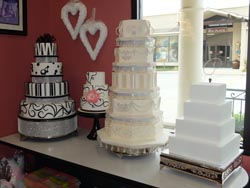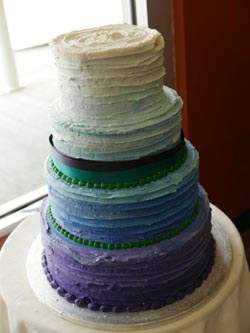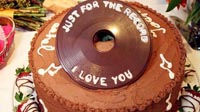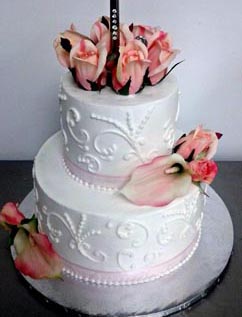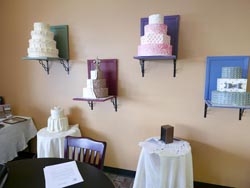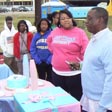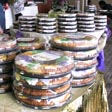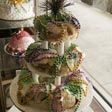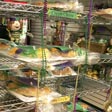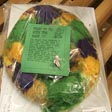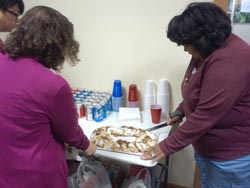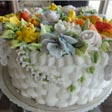A Slice of Life: “Another Reason to Eat Cake”
By Laura Marcus Green
It may be one of the city's best-kept secrets, but not among those who live there. There is just something about the cakes in Baton Rouge. Walk into one of the city's family-owned bakeries and an intoxicating aroma will greet you. A glance inside the display case and the bakery's décor give away the time of year. In January and February, purple, gold and green dominate the scene, as the king cake season holds the limelight. Pastels, bunnies, eggs, and flowers speak of Easter. Mortar boards, diplomas, and portraits printed on fondant-iced sheet cakes appear at graduation time, issuing congratulations. During the fall and winter, people reach for holiday cakes and other baked goods to entertain and comfort. Wedding cakes hold a time and place of their own in the bakeries. In between these occasions, there are birthdays, baptisms, first communions, and all manner of reasons to eat cake!
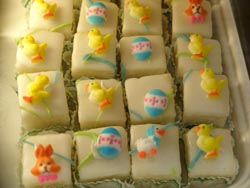
Research for this project included fieldwork at four well-known bakeries, including interviews with some of the people who own and operate these bastions of butter cream bliss. Three of the bakeries are longtime landmarks in Baton Rouge: Baum's Fine Pastries and Chocolates, Joe Gambino's Bakery, and The Ambrosia Bakery. Another Piece of Cake in Central is a more recent arrival, but it has gained a devoted following. Spending time in these bakeries revealed that the people themselves-the owners, bakers, decorators, and counter workers-are a key ingredient to these business' success. Each bakery has its own specialty, its own ambiance, and yet the research shed light upon some common themes among them.
In the bakery business, relationships are cultivated through careful customer service. There is an intimate, behind-the-scenes feeling in the communication that takes place as people place custom orders for birthday cakes for loved ones or plan a wedding. Especially when dealing with regulars, what might otherwise be a business or commercial transaction is personalized, as shopkeepers and their customers share updates and news. Much more than goods and services change hands over the counter in these encounters.
Planning a wedding is serious business. The bakeries all have wedding consultation areas—a space carved out of the sales area, or "the floor." In two cases (The Ambrosia Bakery and Another Piece of Cake) there are separate rooms adjoining the sales areas. All of the wedding consultation areas have display or "dummy" cakes for people to see. These cakes are made from styrofoam forms that are decorated with real icing, from which people can order. Customers can also consult binders containing photos of cakes-mostly wedding and groom's cakes. These areas give a sense of intimacy, even in the midst of a bustling bakery. Because of the relationship built in the course of planning a wedding, bakery staff relate that a couple's wedding and groom cakes often lead to future orders for family occasions like first communions, birthdays, anniversaries, and even the next generation's wedding cakes.
Another similarity among the bakeries was that, in spite of being something of a luxury item, cakes are often deemed "necessary," even during tough economic times. As fewer people bake at home, bakery cakes provide a special treat, often a splurge, but one that people are willing to make. Interestingly, one of the current trends in cake styles at the time of this research was a homemade look, achieved by "rough-icing." Popular cake designs also included lace and burlap (although the latter is waning somewhat) to create a vintage feeling. In the absence of home-baked cakes and other treats for loved ones, people are seeking styles that evoke nostalgia. Customers also go to great lengths to personalize cakes through elaborate decorations.
Groom's Cakes
Nowhere is this personalization more evident, perhaps, than a groom's cake. Groom's cakes are another Baton Rouge specialty. Bakery staff consulted for this project consider groom's cake to be originally a Southern phenomenon that has grown to a national scale. All agreed that the trend in groom's cakes is ever increasing in complexity and elaborateness, limited, as one baker put it, only by a couple's imagination and budget.
Debbie Daigle at Another Piece of Cake especially enjoys working on groom's cakes, as she feels this tradition is the only wedding tradition in which the groom is allowed to shine or to make any significant decisions. Even here, however, she has seen brides take over groom's cake planning. Much is revealed about a couple's dynamics as they order their wedding and groom's cakes. In some cases, brides surprise their grooms, most often choosing a design that reflects their future husbands' profession or hobbies. In these instances, the groom's cake is a gift from the bride to the groom. Sometimes the couple plans the groom's cake together. Alternately, a groom might come in on his own and plan his groom's cake as a surprise for the bride. Some say that the groom's godmother is traditionally the person who orders the cake, and who cuts the first piece of groom's cake at the wedding reception.
Daigle shares her thoughts about Baton Rouge being a special place for grooms cakes:
It is. And it's just a special place anyway, because it has such a unique environment and culture, and you know, our groom's cakes will be a carved crawfish. You know? So we have a lot of unique things here that get transformed over to the cake. You know, hunting is huge here. You'll see cakes carved that look like a deer, and there's a lot of deer- and duck-themed-and fishing is huge. So there's so many neat things that can get transferred over to cakes, that a lot of other places just don't even think about it, because they're not near the water, they don't hunt or whatever. So it's a real unique place to be.
Although career, hobby, football, or liquor-themed cakes are by far the most common designs, groom's cakes can also become a platform for humor or even satire. Many cake decorators work from photos provided by the couple, who might be particular, say, about getting the proportions of their dog just right. Some bakers relish the challenge of constructing a groom's cake, while others find it a stressful part of their work. The bakers talked about cake "carving" techniques, as well as decorating methods like using fondant icing and an airbrush to achieve desired effects. The Ambrosia Bakery makes a hybrid of two cake traditions: a tiered king cake-groom's cake. The bakeries' binders full of photos and online slideshows offer a mind-boggling array of groom's cake designs.
Wedding Cakes
In addition to the lacy vintage wedding cake designs in vogue at the time of this research, bakers reported that some brides prefer a simpler, more down-to-earth feeling for their wedding. Like the groom's cakes, wedding cakes are an expression of a bride's or couple's individuality, tastes, and budget. A recent innovation is the bride's-and-groom's cake, or half-and-half cake, which is a tiered cake that is half wedding or bride's cake and half groom's cake. The bride's side is generally white or light-colored, while the groom's half of the cake tends to be chocolate, which is a longstanding tradition for groom's cakes. The bakers interviewed differed in their preferences for making "real" wedding cakes from which guests are served directly at the reception, versus presenting a "dummy" cake for show and serving slices from sheet cakes that are cut and plated in the wedding venue's kitchen.
It turns out that the delivery of a wedding cake is an important aspect of a baker's work. Only a handful of employees are trained in and entrusted with wedding cake delivery, as this process can mean the difference between a successful cake and a cake that has shifted or fallen or melted during the delivery process. The bakers discourage summertime weddings, as icing does not fare well in the heat of a Louisiana summer. The bakers interviewed have developed techniques for keeping tiered cakes together in transit, from devices inserted in the interior of the cakes, to using shelf-lining grip to keep a cake from sliding around while in the delivery vehicle. Wedding cake delivery staff-most often the bakery owners, managers, or carefully trained employees-travel with a repair kit that includes extra icing and decorating tools, just in case. Several bakery staff shared harrowing stories about salvaging a fallen or melted wedding cake. Knowing how to repair a cake is an important tool of the trade!
We deliver most of them. Now people do get brave and they will come and pick them up, which makes me so nervous. It's almost like it's my baby, you know, until it's set on the table and ready to be, you know, shown to everyone and the bride and everything else. In fact, we had a couple of young men that picked up a cake the other day. It was a rather large cake. It was like a three-tier, but it was like a 16" bottom tier. It served about 200 people. So I'm showing them how to hold it. And they picked it up in a truck. Now it was a huge truck and the seats folded down in the back. But I'm like, "You sure you don't want me to deliver this?" "Oh no, we got it, we got it." So I showed the gentlemen how to hold it. I said, "Now pick it up." And so he said, "Wow, this is a lot more weight to it than I thought." And I said, "Yeah, and that's why you have to keep your elbows tucked in. Quit trying to be manly. Tuck your elbows in to keep that cake level." Cause, that's the main thing. You have to keep it level. "And don't slam your breaks on. Start stopping a block before the red light and the stop sign. You don't want to slam your breaks on." And I said, "Now, here's my cell phone number. When you get the cake there and it's on the table, call me and let me know that it made it there." . . . And he was really good. And he called me and he said it is fine. I said thank you very much. That's all I wanted to know, because I'd have wondered, you know. I'd have wondered.
I have a delivery driver and he's been delivering cakes for Gambino's for years. . . . If there is anything ever a problem, he will tell me when he comes back. He said, there's a little air bubble. We've shown him how to fix things if anything happens. Every so often he'll call and say, "There's an air bubble, but I took care of it." You know, because we showed him how to fix a couple things if something happened. An air bubble, yeah, it happens sometimes with the change in temperature, inside the cake. There's a little air bubble that will kind of poke out on the icing. And you kind of have to poke a hole in it, and you take a piece of paper towel and you flatten it back out and you can't even tell it was there. You know, yeah, so tricks to the trade, tricks to the trade.
Gender Reveal Cakes
Another cake tradition relating to life passages is the gender reveal cake, a fairly recent phenomenon. Expectant couples use cakes to learn the gender of their babies and to share this news with their friends and families. In this tradition, it is customary for a doctor's office or another family member to deliver the results of an ultrasound directly to the bakery, either via a sealed envelope or a phone call. Generally, gender reveal cakes have either pink or blue icing or cake on the inside, but the outer icing is a gender-neutral color. Bakery staff take care when ringing up a gender reveal cake sale, making sure that an expectant couple does not accidentally see the color of icing on an order form when picking up a cake.
A gender reveal cake—or in some instances, cupcakes—might be decorated with the words, "Boy or Girl?" or question marks. Some gender reveal party guests might go as far as wearing pink or blue to the gathering, or t-shirts with "Team Boy" or "Team Girl" printed on them. When the couple cuts the cake, they and their guests learn the baby's gender together. Bakers fill orders for gender reveal cakes regularly, and most say that this tradition has been around for a decade or so. Kelly Landry at Baum's has also made a marriage proposal cake.
King Cakes
King cakes are an important Baton Rouge cake tradition, and a regionally distinctive phenomenon. Angella St. Romain shares her memories of how king cakes went from being exclusive to New Orleans to becoming a regional specialty. She credits Gambino's-known officially as the King of King Cakes-with bringing king cakes to Lafayette and Baton Rouge. Traditional king cake is made from a cinnamon-infused dough, topped with a streusel glaze, and decorated with granulated sugar in the Mardi Gras colors of purple, green, and gold. This traditional color scheme originates in the liturgical colors for this season.
Kelly Landry compares her family tradition of king cakes with king cakes today:
Oh yeah, I remember eating king cake for breakfast. We always had king cake for Mardi Gras. We didn't, I guess-what I find strange is, we never-like Mardi Gras day, had to have a king cake. Like that was never-we would have it throughout the season, but a lot of people here, Mardi Gras Day is the busiest king cake day, as far as people coming in the shop to buy them, like, it's the last day of Mardi Gras, I have to have one. And then there's a lot of people who want to order them after Mardi Gras, which, we don't make them-I mean, it's like a specialty Mardi Gras product. You're not supposed to have it outside of Mardi Gras season. And a lot of people still ask for it."
Bakers talked about innovations in king cake fillings, including, most recently, savory fillings such as pulled pork, taco, and boudin fillings. At Baum's, bakers experiment with new ideas each year, testing out new flavors at staff lunches. The most successful of these concepts become part of that year's offerings, and may be added permanently to the bakery's future repertoire. Recent additions to Baum's' menu of king cake fillings include bananas foster, white chocolate and raspberry, and s'mores.
The bakeries all hire extra staff during king cake season, which runs from King Day or Epiphany, on January 6th, through Mardi Gras. During the season, not only do bakeries fill local orders and sell king cake off the shelf, but they also ship king cakes throughout the U.S. Interviewees shared their techniques for shipping king cake, which include sending the icing and granulated sugar in separate packets and letting customers decorate their own cakes upon arrival. King cake orders come from Louisianans who live out of state or from companies that send king cakes as a special gift to out-of-state clients. Locally, king cakes are the centerpiece at king cake parties, which take place at private parties or the workplace. People like to recite that the tradition is that whoever gets the baby in his or her piece of king cake is obliged to bring the king cake to the following week's party, but this isn't always practiced as it was in the past.
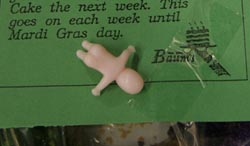
Bakers were divided as to whether to bake the plastic baby figure inside the king cake. Some feel it is traditional and except in the case of a king cake going to a school or special needs setting, people should expect that there will be a baby inside the cake. Others defer to safety, especially in the case of cakes that are shipped out of state to those who may not know this tradition. The latter send the baby outside the cake, with instructions for inserting it.
Trends and the Importance of Service
Bakers report that king cake season fills a gap in their business between the holidays and the wedding season, when sales are otherwise slow. Most bakers only stock king cake in season, but will fill special orders throughout the year. They also make seasonal king-type cakes, with the granular sugar in holiday colors, like pastels for Easter, or red and green at Christmas time.
Bakers noted the influence of the media on cake trends. Television programs like Ace of Cakes have fuelled a cake-decorating craze. Through these shows and social media, customers find inspiration for their cake decorations. Many bring photos of cake designs on their smart phones, asking bakery staff to replicate particular cakes, or customize them. In fact, bakers relate that their customers are often the first indicator of new trends, preempting even the manufacturers and professional baking associations that formerly filled this role.
The use of digital technology has also impacted the way orders and sales are conducted. Several bakeries offer digital slideshows on large monitors. All of them have websites containing information about the range of baked goods and services offered, specials, and ordering information. Customers can order cakes and other bakery items via e-mail, in addition to phone and over-the-counter transactions. Although new technology may streamline the ordering process, in the long run, face-to-face interaction is at the heart of this business.
On the topic of communication, bakery staff all related the importance of listening in order to provide good customer service. At Gambino's, those who take orders use a detailed order form to convey a customer's precise wishes to the bakers and cake decorators. Even with this system in place, mistakes can and do happen. In those instances, listening again becomes an important tool of the trade, as sales staff determine where an order went wrong and strategize how to fix it.
Around the time of her interview Angella St. Romain demonstrated this very principle when a customer came in to pick up her order, and was unhappy with the decorations on her husband's birthday cake. The bakery staff later pointed out that the cake had been made exactly to the customer's specifications, according to the order form. Nonetheless, Miss Angella modeled the way to handle this situation by jumping in and saying calmly, "Now, show me exactly what it is you would like on your cake. We'll make it right for you." It's that age-old adage, "The customer is always right." This etiquette seems generally lacking in today's society, but it is alive in well in some of Baton Rouge's bakeries.
Cakes in Baton Rouge
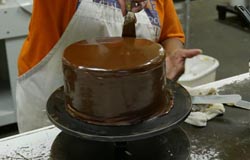
So, what is it about Baton Rouge and cakes? Several bakery staff suggested that Louisiana's distinct cultural and culinary roots and the prevailing foodie culture account for this phenomenon. Two local favorites, the king cake and Doberge (pronounced DOE-bosh) traditions originated in New Orleans and have spread to Baton Rouge and beyond. Debbie Daigle, owner, baker, and decorator at Another Piece of Cake, remarks that the local culture is transferred to cake decorations through such cake designs as the crawfish boil, hunting and fishing, and football—all common groom's cake themes.
Kelly Landry talks about the importance of not changing Baum's icon recipes:
I'm pretty sure our butter cream recipe, we cannot change. The white almond cake with the butter cream is a staple-people come in for that every single day. If we changed that, I don't know how we would stay in business. Dobasch cakes are another thing that have always been the same. There's no reason to change that-that's popular. Our petit fours, people come in here every day for. It's kind of like, if it's not broken, don't fix it. But those are basically the three big things that Baum's has really been known for and we're not going to change any of that.
Angella St. Romain reflects on the importance of bakeries in Baton Rouge culture:
For a city this size, we have a lot of good bakeries and there are more and more popping up. If you travel to other parts of the country, you'll find people who bake cakes at home, or small boutique type shops. But Baton Rouge has some good, longstanding bakeries that have been around for a long time, and we all do a good job. You just don't find that anywhere else, you really don't. . . . I think part of it is, we're still-the South is still very family-oriented. I really do, I think that that just says it all around here. We still go to church, we still have family dinners, we still celebrate holidays, we still enjoy birthdays and having the family and friends over. I mean, food is a big thing here in Louisiana all the way around, and sweets are definitely part of it, you know? And sometimes it's not even a bakery sweet, it might just be mom's old coconut cake or something, but it's definitely part of our culture here, you know, part of that family gathering. We still enjoy family gatherings, and everything that goes along with that. And bakeries and desserts, and just things that bring dear memories are all part of it.
Angella St. Romain at Gambino's attributes the Baton Rouge cake phenomenon to local values around family. She believes that in Baton Rouge and the broader South, family connections remain important. People sit down and share meals together. Many families gather regularly for Sunday dinner and special occasions. Since few contemporary women have time to bake from scratch, they can provide a special dessert for their families with a bakery cake. Angella began her baking career when the Blue Laws prohibiting commerce on Sunday were still in place. Now that bakeries can stay open on Sundays, customers can stop in and pick up their cakes after church or on the same day they are serving a cake. Since cake boxes take up considerable room in the refrigerator, the ability to buy and sell cakes on a Sunday has been a helpful development for all concerned.
Research on bakeries also revealed that cakes are key on many social occasions, often communicating important messages among co-workers, friends, and family. Debbie Daigle spoke about the proliferation of "bakery holidays" in the calendar year, from birthdays and Easter to lesser-known commemorations such as Nurse's Day or Secretary Appreciation Day (formally known as Administrative Professionals Day). Kelly Landry of Baum's referred to this phenomenon as "another reason to buy a cake!"
Sources
Daigle, Debbie. 2015. Another Piece of Cake Bakery. Interview by Laura Marcus Green. April 2.
Jones, Eloise. 2015. Joe Gambino's Bakery. Interview by Laura Marcus Green. April 3.
Landry, Kelly. 2015. Baum's Fine Pastries and Chocolates. Interview by Laura Marcus Green. April 1.
Levin, Cherry. 2013. He Can Have his Cake and We Will Eat It Too: The Role of the Groom's Cake in Southeastern Louisiana Wedding Receptions. Digest: a journal of foodways & culture. Volume 3, Summer
Sherman, Cheryl, Felix Sr, and Felix Jr. 2015. The Ambrosia Bakery. Interview by Laura Marcus Green. April 1.
St. Romain, Angella. 2015. Joe Gambino's Bakery. Interview by Laura Marcus Green. March 30.



